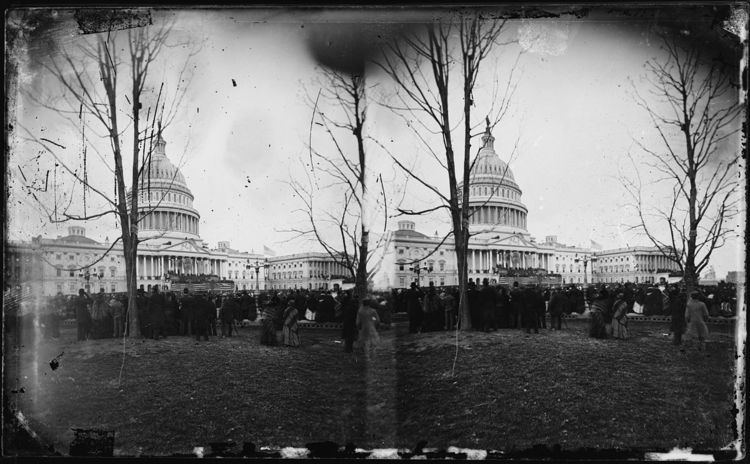The Forty-fifth United States Congress was a meeting of the legislative branch of the United States federal government, consisting of the United States Senate and the United States House of Representatives. It met in Washington, D.C. from March 4, 1877 to March 4, 1879, during the first two years of Rutherford Hayes's presidency. The apportionment of seats in the House of Representatives was based on the Ninth Census of the United States in 1870. The Senate had a Republican majority, and the House had a Democratic majority.
The 45th Congress remained politically divided between a Democratic House and Republican Senate. President Hayes vetoed an Army appropriations bill from the House which would have ended Reconstruction and prohibited the use of federal troops to protect polling stations in the former Confederacy. Striking back, Congress overrode another of Hayes’s vetoes and enacted the Bland-Allison Act that required the purchase and coining of silver. Congress also approved a generous increase in pension eligibility for Northern Civil War veterans.
March 4, 1877: Rutherford B. Hayes became President of the United StatesFebruary 28, 1878: Bland–Allison Act (Coinage Act (Silver Dollar)), Sess. 2, ch. 20, 20 Stat. 25April 29, 1878: National Quarantine Act, Sess. 2, ch. 66, 20 Stat. 37June 3, 1878: Timber and Stone Act, Sess. 2, ch. 151, 20 Stat. 89June 18, 1878: Posse Comitatus Act, Sess. 2, ch. 263, §15, 20 Stat. 152The count below identifies party affiliations at the beginning of the first session of this Congress, and includes members from vacancies and newly admitted states, when they were first seated. Changes resulting from subsequent replacements are shown below in the "Changes in membership" section.
During this Congress, two Senate seats and one House seat were added for the new state, Colorado.
President: William A. Wheeler (R)President pro tempore: Thomas W. Ferry (R)Republican Conference Chairman: Henry B. AnthonyDemocratic Caucus Chairman: William A. WallaceSpeaker: Samuel J. Randall (D)Democratic Caucus Chairman: Hiester ClymerRepublican Conference Chair: Eugene HaleDemocratic Campaign Committee Chairman: Joseph Clay Stiles BlackburnThis list is arranged by chamber, then by state. Senators are listed in order of seniority, and Representatives are listed by district.
Senators were elected by the state legislatures every two years, with one-third beginning new six-year terms with each Congress. Preceding the names in the list below are Senate class numbers, which indicate the cycle of their election. In this Congress, Class 1 meant their term began in the last Congress, requiring reelection in 1880; Class 2 meant their term began in this Congress, requiring reelection in 1882; and Class 3 meant their term ended in this Congress, requiring reelection in 1878.
Skip to House of Representatives, belowThe names of members of the House of Representatives are preceded by their district numbers.
The count below reflects changes from the beginning of the first session of this Congress.
replacements: 5Democratic: 1 seat net gainRepublican: 1 seat net lossdeaths: 2resignations: 3interim appointments: 1contested elections: 0Total seats with changes: 5replacements: 10Democratic: 5 seat net gainRepublican: 5 seat net lossdeaths: 7resignations: 1contested election: 5Total seats with changes: 13Lists of committees and their party leaders.
AgricultureAppropriationsAudit and Control the Contingent Expenses of the SenateCivil Service and RetrenchmentClaimsCommerceDistributing Public Revenue Among the States (Select)District of ColumbiaEducation and LaborElections of 1878 (Select)Engrossed BillsEpidemic Diseases (Select)Examine the Several Branches in the Civil Service (Select)FinanceForeign RelationsHot Springs (Arkansas) Commission (Special)Indian AffairsJudiciaryLate Presidential Election LouisianaManufacturesMexican Relations (Select)Military AffairsMines and MiningMississippi River Levee System (Select)Naval AffairsOrdnance and War Ships (Select)PatentsPensionsPost Office and Post RoadsPrivate Land ClaimsPrivileges and ElectionsPublic LandsRailroadsRevision of the LawsRevolutionary ClaimsRulesTariff Regulation (Select)Tenth Census (Select)TerritoriesTransportation Routes to the Seaboard (Select)Treasury Department Account Discrepancies (Select)WholeAccountsAgricultureAppropriationsBanking and CurrencyClaimsCoinage, Weights and MeasuresCommerceDistrict of ColumbiaEducation and LaborElectionsEnrolled BillsExpenditures in the Interior DepartmentExpenditures in the Justice DepartmentExpenditures in the Navy DepartmentExpenditures in the Post Office DepartmentExpenditures in the State DepartmentExpenditures in the Treasury DepartmentExpenditures in the War DepartmentExpenditures on Public BuildingsForeign AffairsIndian AffairsInvalid PensionsLevees and Improvements of the Mississippi RiverManufacturesMileageMilitary AffairsMilitiaMines and MiningMississippi LeveesNaval AffairsPacific RailroadsPatentsPost Office and Post RoadsPublic Buildings and GroundsPublic ExpendituresPublic LandsRailways and CanalsRevision of LawsRules (Select)Standards of Official ConductTerritoriesWar ClaimsWays and MeansWholeConditions of Indian Tribes (Special)Reorganization of the ArmyTransfer of the Indian BureauArchitect of the Capitol: Edward ClarkLibrarian of Congress: Ainsworth Rand SpoffordPublic Printer of the United States: John D. DefreesChaplain: Byron Sunderland (Presbyterian)Secretary: George C. GorhamSergeant at Arms: John R. FrenchChaplain: John Poise (Methodist)W. P. Harrison (Methodist), elected December 3, 1877Clerk: George M. AdamsClerk at the Speaker’s Table: William H. ScudderJ. Randolph Tucker, Jr.Doorkeeper: John W. PolkPostmaster: James M. SteuartSergeant at Arms: John G. Thompson 
